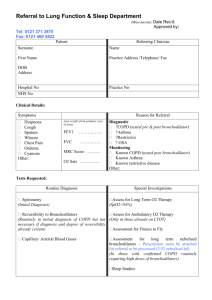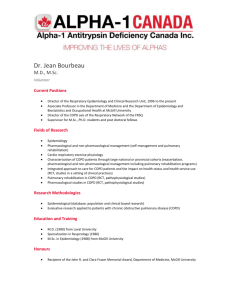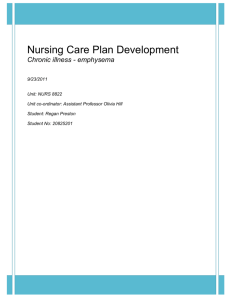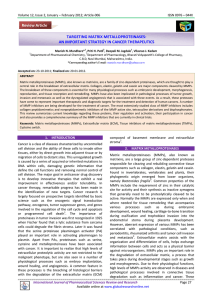Formoterol and ipratropium bromide are two
advertisement
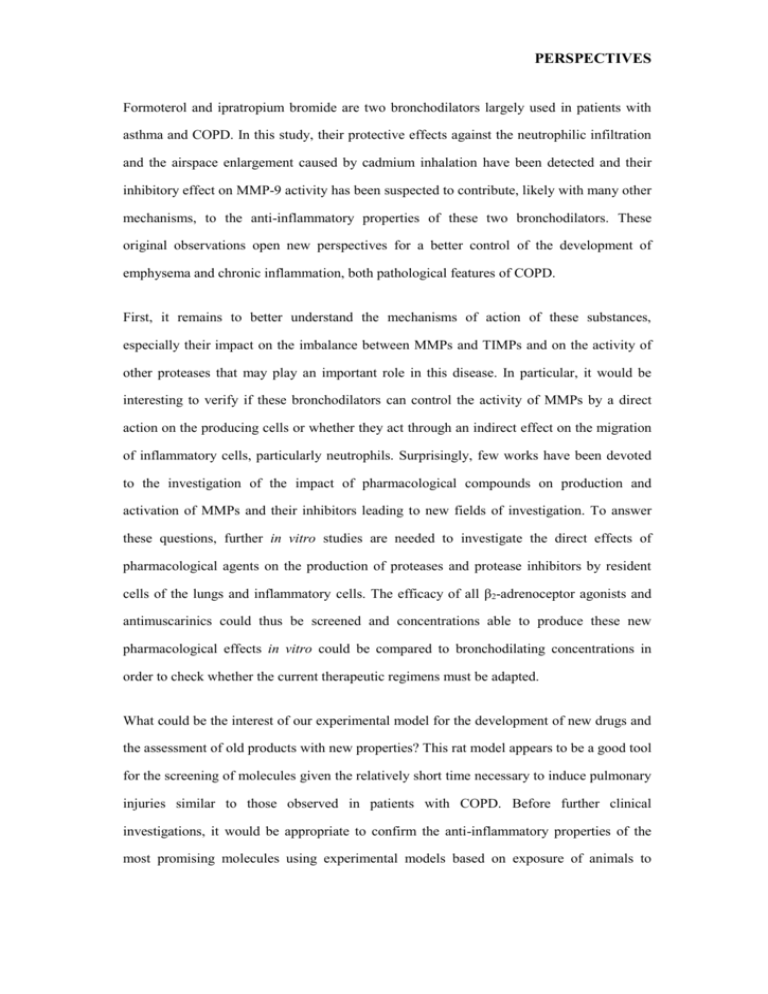
PERSPECTIVES Formoterol and ipratropium bromide are two bronchodilators largely used in patients with asthma and COPD. In this study, their protective effects against the neutrophilic infiltration and the airspace enlargement caused by cadmium inhalation have been detected and their inhibitory effect on MMP-9 activity has been suspected to contribute, likely with many other mechanisms, to the anti-inflammatory properties of these two bronchodilators. These original observations open new perspectives for a better control of the development of emphysema and chronic inflammation, both pathological features of COPD. First, it remains to better understand the mechanisms of action of these substances, especially their impact on the imbalance between MMPs and TIMPs and on the activity of other proteases that may play an important role in this disease. In particular, it would be interesting to verify if these bronchodilators can control the activity of MMPs by a direct action on the producing cells or whether they act through an indirect effect on the migration of inflammatory cells, particularly neutrophils. Surprisingly, few works have been devoted to the investigation of the impact of pharmacological compounds on production and activation of MMPs and their inhibitors leading to new fields of investigation. To answer these questions, further in vitro studies are needed to investigate the direct effects of pharmacological agents on the production of proteases and protease inhibitors by resident cells of the lungs and inflammatory cells. The efficacy of all β2-adrenoceptor agonists and antimuscarinics could thus be screened and concentrations able to produce these new pharmacological effects in vitro could be compared to bronchodilating concentrations in order to check whether the current therapeutic regimens must be adapted. What could be the interest of our experimental model for the development of new drugs and the assessment of old products with new properties? This rat model appears to be a good tool for the screening of molecules given the relatively short time necessary to induce pulmonary injuries similar to those observed in patients with COPD. Before further clinical investigations, it would be appropriate to confirm the anti-inflammatory properties of the most promising molecules using experimental models based on exposure of animals to PERSPECTIVES cigarette smoke whose economic and ethical aspects have been discussed previously in this work. New clinical studies exploring the ability of these drugs to induce these modulatory effects on the balance proteases / protease inhibitors could be conducted taking into account possible interactions with other pharmacological substances such as ICSs. Once the molecules identified and key mechanisms demonstrated in patients with COPD, their relevancy regarding the improvement of lung function and quality of life should be studied. Indeed, it is unclear whether the restoration of the balance proteases / protease inhibitors can systematically result in beneficial effects on lung inflammation. This clinical key aspect should be considered with details. Our work has demonstrated that the pharmacological control of the development of pulmonary emphysema in animals is possible. Few studies have been devoted to this therapeutic aspect of COPD. The search for new molecules and identification of their mechanisms of action on the turnover of the interstitial lung tissue matrix are priorities for the future. In parallel, development of diagnostic tools sensitive enough to detect the protective effects of new drugs on the progression of emphysema in patients with COPD should be encouraged. During our research, one of the most interesting and relevant observations is that the combination of inefficient doses of formoterol and ipratropium produces synergistic effects. In the current state of knowledge, it is often assumed that the anti-inflammatory effects of bronchodilators are of little use in the clinical setting. This apparent contradiction could be explained by the use of inadequate doses. Our data suggest that these effects are only produced at rather high doses which could not be likely easily reached in patients. By contrast, these effects could be induced when drugs are combined due to a synergistic interaction. Thus, further research should be directed towards the investigation of the combined effects of substances such as bronchdilators, corticosteroids and PDE inhibitors, all of them used at low doses. In fact, the interaction of ICSs with one of these two types of PERSPECTIVES bronchodilators or a triple therapy associating molecules of these three therapeutic classes has been yet proposed to better control COPD symptoms, including loss of elastic recoil and airway inflammation in patients with severe airway obstruction. A paper recently published in Am J Respir Crit Care Med highlights the possible benefits of such a combination in patients but arguments remain yet mainly speculative (Welte et al., 2009). Several mechanisms may contribute to the efficacy of this combined therapy, such as a reduction of desensitization of β-adrenoceptors by corticosteroids, an increase in nuclear translocation of glucocorticoid receptors by β2-adrenoceptor agonists and an activation of HDAC2 expression leading to the recovery of the effectiveness of ICSs. The rational of the combination of such compounds with antimuscarinic agents remains to be determined as well as the anti-inflammatory properties and the preventive effects against emphysema of this association. The assessment of these properties could be usefully performed using our experimental model.
